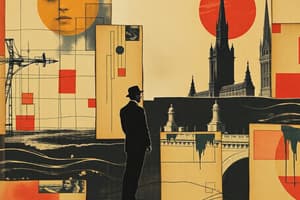Podcast
Questions and Answers
Explain the key differences between the literary movements of Romanticism and Victorianism, highlighting prominent authors and their works from both periods.
Explain the key differences between the literary movements of Romanticism and Victorianism, highlighting prominent authors and their works from both periods.
Romanticism emphasized individualism, emotion, nature, and imagination, with authors like Wordsworth, Coleridge, Shelley, Keats, and Byron. Victorian literature, characterized by social commentary, realism, and moral dilemmas, featured authors such as Charles Dickens, George Eliot, Tennyson, Browning, and Thomas Hardy.
Discuss the evolution of the novel as a literary genre, tracing its development from its origins to the rise of modern and postmodern novels.
Discuss the evolution of the novel as a literary genre, tracing its development from its origins to the rise of modern and postmodern novels.
The novel evolved from picaresque and Gothic forms to realism and social commentary. Modernist novels like Joyce's Ulysses and Woolf's Mrs. Dalloway explored fragmented consciousness and subjective experience, while postmodern novels challenged traditional literary norms and conventions.
Choose one major literary criticism theory, and explain its key tenets and its impact on literary analysis. Provide an example of how this theory can be applied to a specific literary work.
Choose one major literary criticism theory, and explain its key tenets and its impact on literary analysis. Provide an example of how this theory can be applied to a specific literary work.
Possible theories include Formalism, Structuralism, Deconstructionism, Psychoanalytic, Reader-Response, Feminist, Queer, Marxist, or Postcolonial. For example, Feminist criticism examines how gender roles and power dynamics are portrayed in literature.
How does the concept of irony function in literary works? Illustrate your answer with an example from a specific literary text.
How does the concept of irony function in literary works? Illustrate your answer with an example from a specific literary text.
Identify and describe the key features that distinguish a tragedy from a comedy in dramatic literature. Give examples of famous plays that exemplify each genre.
Identify and describe the key features that distinguish a tragedy from a comedy in dramatic literature. Give examples of famous plays that exemplify each genre.
Discuss the impact of colonialism and postcolonialism on English literature, citing examples of authors and their works that explore these themes.
Discuss the impact of colonialism and postcolonialism on English literature, citing examples of authors and their works that explore these themes.
Choose a major literary period from the classical era to the modern era. Describe the key social and historical factors that shaped the literature of this period. Give examples of authors and their works that reflect the significant themes and concerns of the time.
Choose a major literary period from the classical era to the modern era. Describe the key social and historical factors that shaped the literature of this period. Give examples of authors and their works that reflect the significant themes and concerns of the time.
Explain the significance of studying literary works from a variety of cultural contexts. How can this broaden our understanding of the human experience and its complexities?
Explain the significance of studying literary works from a variety of cultural contexts. How can this broaden our understanding of the human experience and its complexities?
Flashcards
Classical Literature
Classical Literature
Focuses on Greek, Roman, and Sanskrit works, featuring authors like Homer and Virgil.
Renaissance Literature
Renaissance Literature
Literature from the Renaissance period, including works by Shakespeare and Milton.
Romantic Literature
Romantic Literature
A literary movement emphasizing emotion and nature, featuring poets like Wordsworth and Byron.
Victorian Literature
Victorian Literature
Signup and view all the flashcards
Poetry Genres
Poetry Genres
Signup and view all the flashcards
Literary Criticism
Literary Criticism
Signup and view all the flashcards
Cultural Context
Cultural Context
Signup and view all the flashcards
Figures of Speech
Figures of Speech
Signup and view all the flashcards
Study Notes
English Literature: Classical to Contemporary
- Classical literature encompasses Greek, Roman, and Sanskrit works, including authors like Homer, Virgil, and Sophocles.
- Medieval literature features Chaucer and other medieval English authors.
- Renaissance literature includes Shakespeare, Marlowe, Spenser, and Milton.
- 17th and 18th-century literature includes metaphysical poets (e.g., John Donne), Restoration Drama, and Augustan prose and poetry (e.g., Dryden, Pope, Swift, Addison).
- Romantic literature features major Romantic poets such as Wordsworth, Coleridge, Shelley, Keats, and Byron.
- Victorian literature showcases authors like Charles Dickens, George Eliot, Tennyson, Browning, and Thomas Hardy.
- Modern and postmodern literature includes authors like James Joyce, Virginia Woolf, T.S. Eliot, W.B. Yeats, Samuel Beckett, W.H. Auden, Philip Larkin, and Harold Pinter.
- Indian literature in English features authors like R.K. Narayan, Mulk Raj Anand, Salman Rushdie, Arundhati Roy, and Amitav Ghosh.
Genres and Movements
- Poetry encompasses epic, lyric, sonnet, elegy, and satire.
- Drama includes tragedy, comedy, tragicomedy, and absurd drama.
- Novel encompasses picaresque, gothic, historical, realist, and modernist novels.
- Short stories are also a genre.
- Literary criticism includes classical criticism (e.g., Aristotle's Poetics), romantic criticism (e.g., Wordsworth, Coleridge), and modern criticism (e.g., New Criticism, Structuralism, Post-Structuralism).
- Critiques include feminist criticism, postcolonial theory, psychoanalytic theory, and Marxist criticism.
Critical Approaches
- Formalist, structuralist, and deconstructionist approaches.
- Psychoanalytic and reader-response theories.
- Feminist, queer, Marxist, and postcolonial criticism.
Literary Terms and Devices
- Figures of speech, narrative techniques, and dramatic devices.
- Key concepts include allegory, irony, paradox, symbolism, imagery, and allusion.
Cultural and Historical Contexts
- Understanding socio-political and cultural backgrounds of literary periods.
- Colonialism and postcolonialism.
- Modernism and postmodernism are important contexts.
English Language
- Evolution of the English language.
- Grammar, syntax, and phonology.
Studying That Suits You
Use AI to generate personalized quizzes and flashcards to suit your learning preferences.



